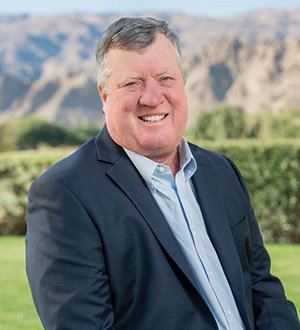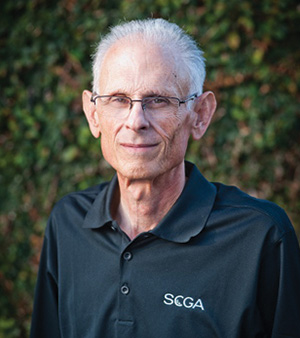
Hole No. 17 “Alcatraz” at the Pete Dye Stadium Course at PGA West in La Quinta, Calif., where Brian Sullivan, CGCS, MG, is director of agronomy. Photo by John Henebry
Twenty years ago in southern California, meetings between city governments and golf representatives were often chilly at best, said Brian Sullivan, CGCS, MG, director of agronomy at PGA West in La Quinta, Calif.
“In the early 2000s, when we met with the city, we were the enemy,” said Sullivan, a 39-year GCSAA member.
That was a decade before the formation of the Coachella Valley Golf and Water Task Force, which has been recognized with GCSAA’s 2025 Excellence in Government Affairs Award.
“Now we’re anything but the enemy,” Sullivan said. “Due to the efforts of the task force, we’ve got very sophisticated yet very simple water conservation practices in use — and so golf isn’t the target anymore, we’re not the enemy. It’s a group of people with common interests, and there’s some brilliant minds that really have some foresight and understanding of the issues.”
Sullivan got involved in the task force because, with nine courses spanning more that 2,000 acres, PGA West is one of the heaviest users of water in the Coachella Valley. He attends the bimonthly meetings, along with about 20 other people, including five or six superintendents, a couple of general managers, Southern California Golf Association staff and representatives of the USGA and GCSAA.
Among the task force’s primary goals is to transition courses to use more sustainable canal water from the Colorado River instead of using groundwater from the desert’s aquifer. PGA West has transitioned to using about 80% of its water from the canal.
“That of course was not the case years ago, so we’re trying to be a leader. That was the original goal of the task force, was to substitute groundwater with river water,” Sullivan says. “PGA West had benefited from the work of the task force before I got here. As a very large golf operation, the mere fact that we have a reliable source for a resource that we absolutely need, I’m lucky to step into something that’s as organized as it is.
“The task force is not social at all. Everyone gets down to business. We’ve got things we’ve agreed upon, and we meet to further those goals. In the valley, there’s a high level of understanding of water issues. Superintendents are an educated group, and I would sincerely doubt that any superintendent in the valley isn’t very aware of the task force and what it’s trying to do to assist golf and their access to water.”

No. 11 on the Greg Norman Course at PGA West. Photo by Evan Schiller
Recognized for representing golf
The task force earned the 2025 Excellence in Government Affairs Award for its advocacy on a wide array of water issues facing the golf industry throughout the Coachella Valley.
The award recognizes a chapter, superintendent or coalition for outstanding advocacy or compliance efforts in government affairs. The task force was formally honored at the 2025 GCSAA Conference and Trade Show in San Diego.
The Coachella Valley has the largest concentration of golf courses in the United States and faces water and climate-related challenges that threaten the industry. The task force is a partnership between the Coachella Valley golf community and the Coachella Valley Water District and was established in 2014 for the purpose of meeting the conservation goals of the Coachella Valley Water Management Plan, including facilitating the substitution of the Colorado River water for groundwater. It is made up of golf facilities, members of two GCSAA-affiliated chapters (Hi-Lo Desert GCSA and GCSA of Southern California) and other water and golf industry stakeholders.
Craig Kessler serves as the task force’s chairman and is a public affairs consultant for the SCGA. “It’s nice to be recognized by a national organization with this award,” Kessler says. “Over the 10 years of its life, the Coachella Valley Golf and Water Task Force has brought tangible, practical and quantifiable benefits to the golf clubs in California’s Coachella Valley, rendering the hours spent by those who brought those benefits time well-spent for not just their clubs but for all 121 golf facilities in the Coachella Valley.”
Brian Sullivan, CGCS, MG, is the director of agronomy at PGA West in La Quinta, Calif. Photo courtesy of Brian Sullivan

Kessler said the task force is effective because it brings together an array of expertise and facilitates communicating joint decisions in the public policy arena. He said the opportunity to participate in public policymaking shouldn’t be taken for granted because it’s a difficult thing to achieve effectively.
“Effective advocacy doesn’t happen just because you bring three agronomists and a botanist to the table. It’s important that they be at the table because they’re the experts and can shape decisions on public policy. However, there’s nothing about their background or training that prepares them to be able to communicate that or to be able to understand how government works or how media works and so forth,” Kessler said.
That’s what the task force does, he said: “It’s our job to provide a forum where golf course superintendents and agronomists can bring their expertise to the table and have it factored into the regulations and laws that govern what they do every day.”

No. 17 on the Norman Course at PGA West. Photo by John Henebry
Weaning off groundwater
Among the benefits of the task force’s work is facilitating connections to the Colorado River water canal to help transition golf courses off of groundwater. Kessler said it would be cost-prohibitive for courses that are farther away from the river water canal to pay for their own connections, so the water district, working with the task force, has issued debt instruments to pay for connections over 40 years through fees to all rate payers, not just the beneficiaries.
“The desert (economy) exists because it sits on one of the deepest and richest aquifers in the world. As deep and rich as it is, it needs to be in a position of stability so that as much is taken out is put back into it. That has created obligations on all sectors of the desert economy, but golf is a huge sector,” Kessler says. “We need to substitute other sources of water for the water that’s in the ground. The primary mechanism for that is to take raw water off the Colorado River. That requires hookups. Now the district itself pays a substantial amount of the cost of doing the hookup and bringing it to the facilities.”
That is a direct result of the task force’s work, he said.
Craig Kessler is the chairman of the Coachella Valley Golf and Water Task Force, and a public affairs consultant for the Southern California Golf Association. Photo courtesy of Craig Kessler

“How does that benefit a superintendent? You’re not going to have 121 golf courses in that valley if these kinds of things weren’t done. It would ultimately shrink to 70 or 80, because clubs would close,” Kessler says.
Moving more facilities to Colorado River water or sources of recycled water was one of the task force’s two major founding goals. Kessler said golf facilities have done an “exemplary” job working toward that goal. Ultimately, the goal is to connect 95 facilities; currently, there are close to 60 connected.
“If it wasn’t for the constant pressure of this task force, that would have been less, particularly in lean economic times,” Kessler says.
The other goal was to reduce all water use by 10% by 2020. Kessler said in that regard, golf facilities fell somewhat short, reducing use by 8.6%.
“Moving forward, those goals have changed slightly,” Kessler said, largely due to changing allocations of Colorado River water. “In 2026, there’s going to be a new set of arrangements among the seven states of the (Colorado River) compact. We don’t know the details of that yet, but we know there will be less water available. How to cope with that will be the next great challenge of (the task force).”

Coachella Valley Golf and Water Task Force reps onstage at the 2025 GCSAA Conference and Trade Show. Photo by Darren Carroll
Less is more
Efforts are continuing and expanding to reduce water usage in other ways, Kessler said. In addition to removing turf from courses, some courses are converting turf to less-thirsty cultivars such as TifTuf. He said particularly promising are new strains that stay green longer and lessen the need for overseeding.
“Avoiding overseeding is probably the direction that is going to ultimately save the most water,” Kessler said.
Jeff Jensen — GCSAA field staff representative for the southwest region — attends many of the task force’s meetings. He said the partnership between the water district and the valley’s 121 golf courses has provided numerous and measurable benefits to the water district, golf facilities and local community.
“Through the efforts of the task force, golf facilities in the valley have been able to reduce groundwater use, provide financial assistance to implement numerous conservation programs, increase hookups to recycled water and collaborate on other projects that have reduced golf’s water footprint in the valley,” Jensen says.
Kessler said as the work of the task force continues, it is important to remember that public policy is not transactional — it is a long-distance run, he said.
“This work involves creating narratives about yourself that then become absorbed by others so that the context in which you operate becomes friendlier and friendlier over time and the results become better and better. That’s hard to put a number on, but it’s invaluable,” Kessler says. “Having a meaningful seat at the table where the decisions are made about the rules affecting your golf course every day is worth its weight in gold.”
Phil Cauthon (pcauthon@gcsaa.org) is GCM’s managing editor.